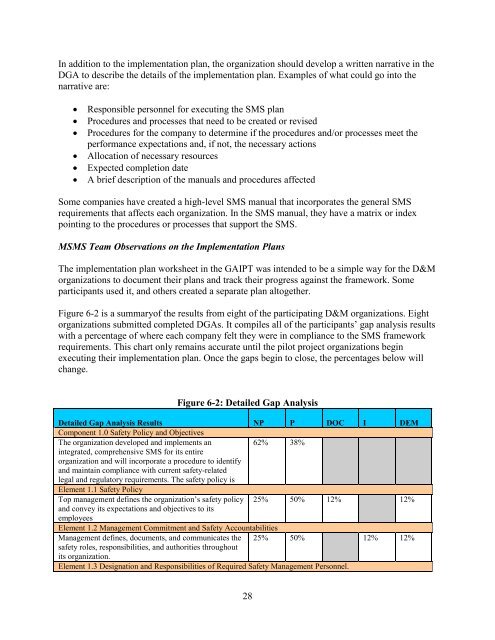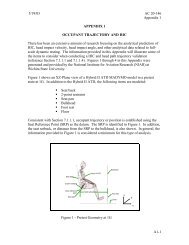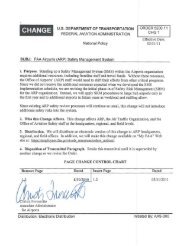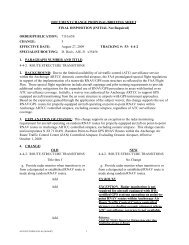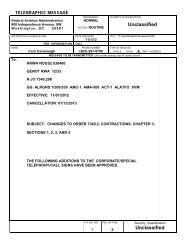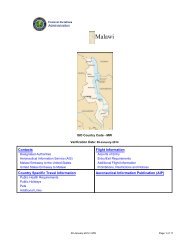2009 SMS Pilot Project (SMSPP) Analysis - FAA
2009 SMS Pilot Project (SMSPP) Analysis - FAA
2009 SMS Pilot Project (SMSPP) Analysis - FAA
Create successful ePaper yourself
Turn your PDF publications into a flip-book with our unique Google optimized e-Paper software.
In addition to the implementation plan, the organization should develop a written narrative in the<br />
DGA to describe the details of the implementation plan. Examples of what could go into the<br />
narrative are:<br />
• Responsible personnel for executing the <strong>SMS</strong> plan<br />
• Procedures and processes that need to be created or revised<br />
• Procedures for the company to determine if the procedures and/or processes meet the<br />
performance expectations and, if not, the necessary actions<br />
• Allocation of necessary resources<br />
• Expected completion date<br />
• A brief description of the manuals and procedures affected<br />
Some companies have created a high-level <strong>SMS</strong> manual that incorporates the general <strong>SMS</strong><br />
requirements that affects each organization. In the <strong>SMS</strong> manual, they have a matrix or index<br />
pointing to the procedures or processes that support the <strong>SMS</strong>.<br />
M<strong>SMS</strong> Team Observations on the Implementation Plans<br />
The implementation plan worksheet in the GAIPT was intended to be a simple way for the D&M<br />
organizations to document their plans and track their progress against the framework. Some<br />
participants used it, and others created a separate plan altogether.<br />
Figure 6-2 is a summaryof the results from eight of the participating D&M organizations. Eight<br />
organizations submitted completed DGAs. It compiles all of the participants’ gap analysis results<br />
with a percentage of where each company felt they were in compliance to the <strong>SMS</strong> framework<br />
requirements. This chart only remains accurate until the pilot project organizations begin<br />
executing their implementation plan. Once the gaps begin to close, the percentages below will<br />
change.<br />
Figure 6-2: Detailed Gap <strong>Analysis</strong><br />
Detailed Gap <strong>Analysis</strong> Results NP P DOC I DEM<br />
Component 1.0 Safety Policy and Objectives<br />
The organization developed and implements an<br />
62% 38%<br />
integrated, comprehensive <strong>SMS</strong> for its entire<br />
organization and will incorporate a procedure to identify<br />
and maintain compliance with current safety-related<br />
legal and regulatory requirements. The safety policy is<br />
Element 1.1 Safety Policy<br />
Top management defines the organization’s safety policy 25% 50% 12% 12%<br />
and convey its expectations and objectives to its<br />
employees<br />
Element 1.2 Management Commitment and Safety Accountabilities<br />
Management defines, documents, and communicates the 25% 50% 12% 12%<br />
safety roles, responsibilities, and authorities throughout<br />
its organization.<br />
Element 1.3 Designation and Responsibilities of Required Safety Management Personnel.<br />
28


